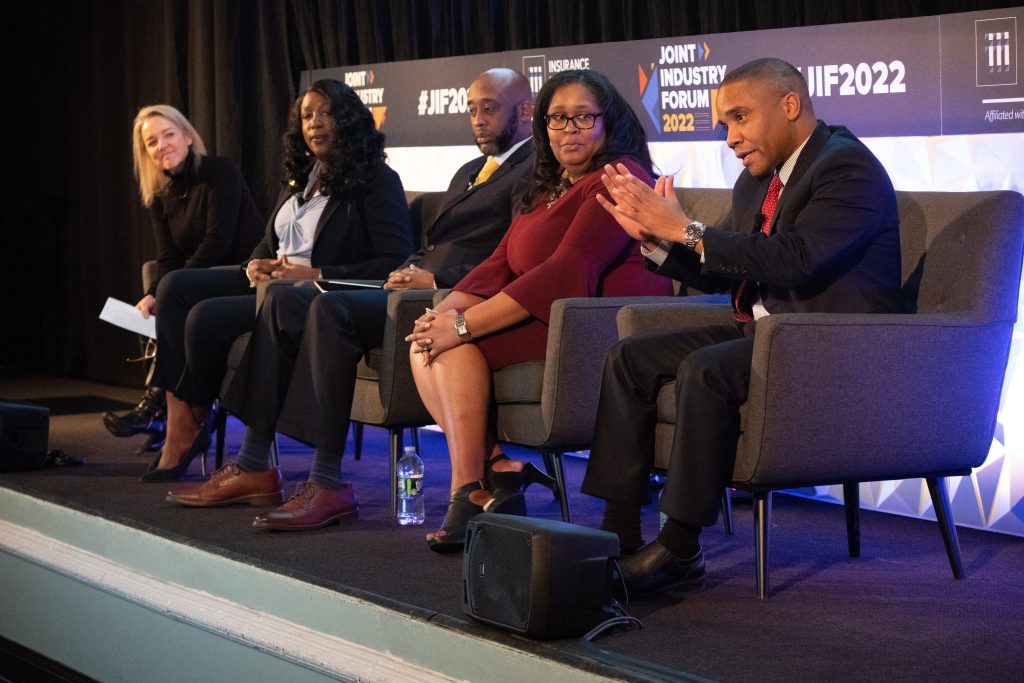A Discussion of Progress and Challenges in Diversity, Equity, and Inclusion at JIF 2022

By Max Dorfman, Research Writer, Triple-I
At JIF 2022, a panel assembled to discuss the importance of diversity, equity, and inclusion (DEI) in the insurance industry.
Jennifer Kyung, Property & Casualty (P&C) chief underwriter, USAA and Triple-I Chair, moderated the discussion, which focused on a wide array of issues, including the talent gap.
“We need to put a focus on talent in the insurance industry, and make sure that the talent is diverse,” Kyung stated in her opening. “We have hundreds of thousands of jobs that we need to fill, and we need to fill those with people who have the best skill sets.”
For Roosevelt C. Mosley Jr., principal and consulting actuary, Pinnacle Actuarial Resources, the approach to DEI has a significant impact. Mosley noted that it is a sensitive issue, with people having different interpretations.
“We all have differences,” Mosley said. “But we have to recognize that we’re different, and if we’re going to serve diverse communities, we need to be diverse, too.”
“Bringing more diverse talent to the industry is good, but that’s not enough,” Mosley added. “They need to feel included. We haven’t completed the process if they don’t feel included.”
For Traci Adedeji, president-elect, CPCU Society, “diversity is differences that exist whether we choose to call them out or not.”
“A DEI strategy really has to be baked into the DNA of an organization,” Adedeji said. “It’s what you want your culture to be.”
Adedeji added that equity and inclusion necessitate intentional actions within an organization.
“When I think of DEI, it’s about considering all the key stakeholders,” said John Tribble, vice president, Agency Operations and Business Development, Church Mutual. “When I think about diversity, it’s simple: does the leadership have the foresight and willingness to step into situations that are uncomfortable for them?”
Tribble added that if one company does not strive for this, a competitor will do it, leading to a loss in market share.
For Rebekah Ratliff, mediator, arbitrator, neutral evaluator and settlement master, JAMS, there is an extra step in the DEI equation.
“The belonging piece to DEI is inviting people to bring their gifts and talents, understanding that it will make the experience richer for everyone,” Ratliff said. “Research shows it’s a business imperative to have diverse thinkers, participants, people from different cultures, backgrounds, and experiences.”
Ratliff furthered the point, saying, “It’s about examining, assessing, and revamping cultures to utilize people in the right spaces, people from underutilized communities. It’s not just about the faces but putting people in the right positions.”
The panelists agreed that this process has to come from the highest echelons of the company. Mandates and incentives, they said, are a necessary part of this.
The question, Kyung posed, is how the insurance industry is doing with DEI compared to other industries, and where further progress can be made.
“Company culture has to be examined,” Ratliff said. “We have to be truthful about the deficiencies and barriers to entry. 400,000 jobs are coming open. Companies are spending millions of dollars replacing technology, but they’re not willing to spend money on the biggest risk: people. People are our biggest asset and our biggest risk.”
“Our work is incomplete,” Mosley said. “I say that because, with 30 years of experience, the industry looks vastly different, but sometimes progress has been slow and difficult.”
“We are doing better but we’re not there,” Adedeji said. “The fact that we’re in this room having this conversation is progress. It’s important to bring in diverse talent, but if the leadership doesn’t lead to mentorship, sponsorship and bubbling up to senior levels of the organization, then we’re being disingenuous.”
Tribble concluded, “A lot of us aren’t comfortable with being uncomfortable.”





